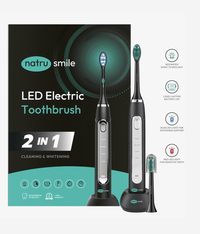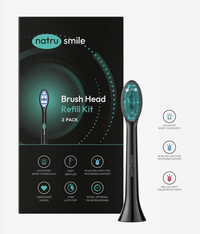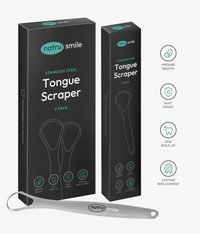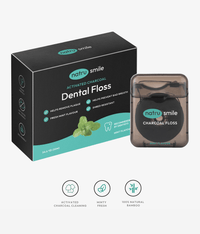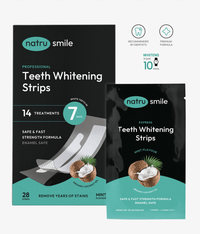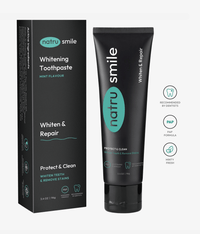
All products are certified by dental expert Dr. Greg Grillo
Are you longing for an attractive smile but dread the thought of visiting the dentist? Fear not, as in-office teeth whitening isn't your only option. The world of at-home teeth whitening offers an abundance of convenient alternatives.
Among these, whitening pens and strips stand out as two popular choices for those seeking pearly whites without stepping foot in a dental clinic. With countless other methods available such as trays and gels, what sets these options apart?
Join us on this illuminating journey as we delve into the captivating world of teeth-whitening pens and strips. By examining their unique features and benefits, we aim to empower you with the knowledge to confidently choose the perfect solution for your brightest smile yet – all from the comfort of your own home.
Teeth Whitening Pens Vs Strips: Which One Is Right For You?
To get a good understanding of which cosmetic dentistry product is right for you, we'll take a brief look at what each product is and how they are different.
Let’s start with teeth whitening pens. These products offer more precise application than strips because they allow users to target specific areas of their mouths more easily due to their small brush-tip applicators. They also typically contain stronger whitening agents than strips, making them more effective. However, these products are messier to use and often require multiple applications for the best results.
The advantages of teeth whitening strips are that they are easier to apply and typically don’t require as many applications for desired results. They also tend to cost less than pens and come in a variety of sizes that accommodate different mouths. The downside is that they are not as precise when it comes to targeting specific areas of your mouth. Furthermore, their ingredients may not be as strong as those in pens, meaning you might have to wait longer for noticeable results.
So, which product should you choose? Ultimately, it depends on your goals and budget. If you’re looking for fast results with precision whitening, a tooth whitening pen might be the way to go. However, if you want an easy-to-use solution that won’t break the bank and still offers decent results, then teeth whitening strips may be a better choice for you.
What Whitens Better - Whitening Strips Or Whitening Pen?
The answer to this question depends on your individual needs and preferences. Teeth whitening pens are a convenient and affordable way to brighten teeth, but their effects may not be as immediately noticeable or long-lasting as those of traditional strips. Applying strips takes more time and effort, but they often provide better results than pens.
It's also important to note that, according to the American Dental Association (ADA), only some whitening products bear their Seal of Acceptance and have followed the guidelines to get there, and those products include whitening strips and whitening toothpaste. So while pens seem like the easier option, they may not be as safe or healthy for you as strips.
Main Differences Between Whitening Pens And Strips
So far, we've done a quick overview of what whitening pens and strips are and how they are different. Now, let's dive into their key differences to determine for certain which is the best choice for you.
Effectiveness Comparison
When it comes to effectiveness, whitening strips are the clear winner here. They contain a higher concentration of active ingredients than whitening pens and typically last longer. Therefore, they provide more effective results in less time when compared to whitening pens.
You should make sure to look at the ingredient label before making your choice, though. Effective and healthy whitening strips contain hydrogen peroxide as their active ingredient, while others use chlorine dioxide. This ingredient has the potential to remove the enamel from your teeth and make them more sensitive and prone to staining. This makes the product dangerous and ineffective, so be sure to be a discerning consumer when making your choice.
Cost Comparison
At-home teeth whitening kits have a wide range of prices. Dentaly suggests the teeth whitening cost for over-the-counter products is anywhere from $15 to $400. But when you look more specifically at whitening strips and pens, whitening strips are a more affordable option.
Most whitening strips are purchased at drug stores or online for around $20-30 and many come in multi-packs with enough product for multiple applications. Whitening pens, however, usually cost around $50 each and don't come in packs, so you'll need to purchase one pen per application.
Quality Of Ingredients
An important factor to consider when deciding between whitening pens and strips is the quality of the ingredients present. In general, whitening pens contain higher-quality ingredients than strips. This means that a pen provides better coverage and more effective results in an easier way.
Whitening pens usually include hydrogen peroxide or carbamide peroxide as the active ingredient. These ingredients are more effective and safe than those found in some whitening strips, especially those that contain chlorine dioxide.
Convenience Comparison
When it comes to convenience, whitening pens come out ahead. They are small and portable and are used anywhere, anytime – even while on the go. The application process is much quicker than that of strips, as you draw a thin line along your teeth with the pen. Strips require more time since they must be applied to each tooth one at a time and then adhered carefully in place for several minutes before being removed.
Treatment Time
Whitening pens often require a longer period of application in comparison to whitening strips. A typical whitening pen will need at least 10 minutes of application per day for at least 2 weeks to see satisfactory results. Whitening strips are applied quickly and work much faster than their pen counterparts. Generally speaking, they only need 1-2 days of use before you start seeing your teeth become whiter and brighter.
The length of application for pens has the added benefit of specificity. Your control over the application process means it takes longer, but it also means you attack specific areas of your teeth instead of the general approach given by whitening strips.
Now that you know the specifics of whitening pens and strips, let’s dive even deeper and answer some of your lingering questions.
Are Whitening Pens And Strips Effective?
Yes, whitening pens and strips are effective in whitening teeth. Whitening pens contain hydrogen peroxide, which is a common teeth-whitening agent. Strips are coated with a thin layer of hydrogen peroxide-based gel that adheres to the surface of your teeth and helps break up stains. Make sure whichever product you choose contains hydrogen peroxide, however, as other active ingredients are not as effective and may even be harmful.
Will My Teeth Get Sensitive Using Whitening Pens Or Strips?
Both whitening pens and strips are safe and effective for most people. However, some may experience sensitivity after use, especially if they already suffer from sensitive teeth. It is best to consult with a dentist before using either of these products to minimize the risk of any issues or discomfort.
You may also experience sensitive teeth if the product you use contains chlorine dioxide. Chlorine dioxide is a bleaching agent, and its presence in the product makes your teeth more sensitive. It’s best to look for teeth-whitening products that contain other, less abrasive ingredients, such as hydrogen peroxide or carbamide peroxide.
Can I Trust The Quality Of Ingredients In Whitening Pens And Strips?
Yes, you should trust the quality of ingredients in whitening pens and strips. Both products usually contain hydrogen peroxide or carbamide peroxide, which are commonly used teeth-whitening agents. Strips also tend to come with a gel that contains additional active ingredients like sodium bicarbonate and potassium nitrate. These are all safe ingredients, but be wary of chlorine dioxide as the active ingredient, as it may do more harm than good for your teeth.
How Long Will It Take To See Results?
The answer to this question depends on which option you use. Teeth whitening pens typically take a few weeks to show results, while strips often show results in as little as one week. This is because the application time for pens is generally much longer.
Does Insurance Cover Whitening Pens And Strips?
No, most insurance plans do not cover teeth whitening treatments. The cost of using a whitening pen or strips out-of-pocket will vary depending on the type of product you go with. Generally, whitening pens are more expensive than strips, but it all depends on which brand you choose.
Are Whitening Pens Better Than Strips?
This depends on you and your unique needs. Whitening pens are convenient, easy to use, and are taken anywhere. They offer a more targeted approach to whitening, which is especially useful for those with sensitive teeth or gums.
Whitening strips provide more even coverage across your entire mouth, making them ideal for large areas of discoloration. Ultimately it comes down to what works best for you. If you are having trouble deciding, you should consult with your dentist to determine which method is best for you.
How Long Should You Leave A Whitening Pen On Your Teeth?
Whitening pens should be left on your teeth for only a few seconds. Once you have applied the whitening gel, you should use a soft toothbrush to spread it around and make sure that all areas of the teeth are covered. After brushing your teeth, spit out any excess gel and rinse with water. Usually, one application per day is enough to see results in just a few days.
What’s The Difference Between Zoom! And Laser Teeth Whitening?
If you're expanding your debate to in-chair vs teeth whitening products, Zoom or laser teeth whitening are two of the most popular options for in-office whitening. They both are professional treatments that typically involve a light-activated bleaching process and are costly. Here are some of the key differences between laser teeth whitening vs zoom.
Zoom whitening is a light-activated bleaching process that utilizes 25% hydrogen peroxide gel and ultraviolet light. It’s designed to target deep stains and discoloration quickly, with results that last up to three years. The procedure typically takes about 45 minutes in the dentist’s chair, but some people may need more than one session for optimal results.
Laser teeth whitening is slightly different from Zoom, as it uses laser technology to activate the bleaching agent (which is usually between 10 – 35 % hydrogen peroxide). Depending on the severity of your staining or discoloration, laser teeth whitening may take up to two hours in the dentist’s chair. Results last for several years with proper maintenance and care.
What’s Better: Teeth Whitening Or Bleaching?
When debating teeth whitening vs bleaching, it’s essential to understand the differences between the two. Teeth whitening is a process that uses special chemicals or gels to reduce discoloration and make teeth look whiter. Bleaching, on the other hand, involves using a stronger solution that removes stains from teeth by breaking down molecules in them.
Bleaching is usually considered to be more effective for removing deep discoloration and staining, but it also causes sensitivity in some people. Therefore, it's up to how deep your stains are and your sensitivity level.
What Are Dental Crowns And Veneers?
Dental crowns and veneers are two types of dental treatments used to restore the look of your teeth. Essentially, they are whitening options for severely discolored teeth that are not helped by over-the-counter or in-office whitening treatments.
There are some key differences between a dental crown vs veneer. Dental crowns are a type of restoration that encases the entire tooth, while veneers are thin shells that cover just the visible part of a tooth. Both help improve the shape and color of your teeth, as well as protect them from further damage.
What Is Dental Bonding Compared To Veneers?
If you are debating between a dental bonding vs veneer procedure, only one is helpful for whitening teeth. Dental bonding is a procedure in which a tooth-colored composite resin material is applied to the surface of the teeth and hardened with a special light. It is used to fix minor chips, gaps, or discolorations on the front teeth.
Veneers are thin pieces of porcelain that are cemented over the front side of your teeth for cosmetic purposes. While veneers help make your smile whiter and brighter, they cannot whiten existing stains on your teeth.
Wrapping Up
Both whitening pens and strips are effective ways to improve your smile, but there are some key differences between the two. Whitening pens often contain higher concentrations of bleaching agents than strips, which means they provide more dramatic results. Whitening strips have a lower concentration of bleaching agent and must be applied over time to achieve desired results. Strips also tend to be less expensive than pens. So, which one works better?
It depends on the individual. Some people may find that whitening strips are more effective for them, while others may prefer to choose a whitening pen. Ultimately, it’s up to you to decide which method works best for your needs and budget. Use what you’ve learned here to ask well-informed questions of your dentist so they help you see what the best option for your teeth is.


